
With the whole world to explore, this wild spirit found himself caged at the Tower of London
Sir Walter Raleigh was one of the most famous explorers of Elizabeth I's reign. His courage and good looks made him a favourite of the Queen's, and she rewarded him handsomely. Raleigh was also a scholar and a poet, but he is usually remembered for introducing the essential potato, and the addictive tobacco.
However, his reckless nature eventually made him unpopular at court. He managed to displease both the Queen and her successor James I, and so found himself a prisoner of the Tower of London – no less than three times!
As a gentleman, he was deprived of his liberty, but not his comforts: his family could visit, he grew exotic plants and started his book ‘The Historie of the World’. However, on his release, Raleigh angered the King once again. He was charged with treason and executed outside the Palace of Westminster in 1618.
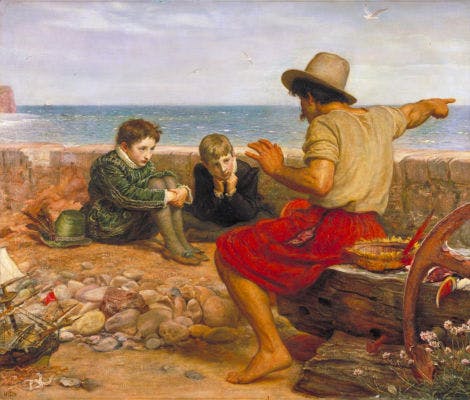
Image: Sir John Everett Millais, Bt. The Boyhood of Raleigh, 1870. Tate Collection. © Tate. CC-BY-NC-ND 3.0 (Unported).
In Millais’s famous painting he is shown as a boy (in green) listening with rapt attention to ‘tales of wonder on sea and land’ told by a Genoese sailor.
Raleigh's early life
Sir Walter Raleigh was born in Devon in around 1554, the youngest of five sons of Catherine Champernowne and Walter Raleigh, both in their second marriages. His family was very well connected; Catherine’s aunt had been Elizabeth I’s governess while a princess. His half-brother Humphrey Gilbert was a prominent explorer and Member of Parliament, as was his brother Carew Raleigh.
An early lesson in hate
Walter grew up in a family of devout Protestants, who were persecuted during the brief reign of Catholic Mary I (1553-8). From an early age Walter developed a hatred of Catholicism that would last for the rest of his life.
He was educated at Oxford (although he never finished his degree) and in London.
Did you know?
When he was 17 years old, Raleigh fought with the Huguenots (French Protestants) in France during the Wars of Religion.
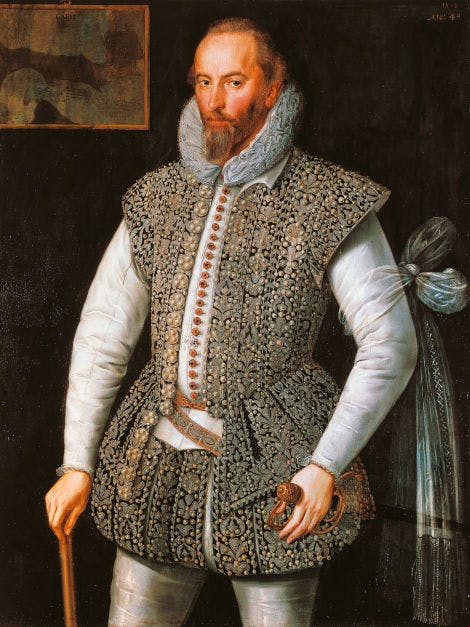
Image: Portrait of Sir Walter Raleigh, © akg-images / De Agostini Picture Library
Walter Raleigh, the royal favourite of Elizabeth I
After joining an expedition to North America with his half-brother Sir Humphrey Gilbert in 1578, the intrepid Raleigh first came to the attention of Queen Elizabeth I in 1580, when he went to Ireland to help suppress an uprising in Munster. He was invited to court, where he soon made an excellent impression on the Queen with his good looks and gallantry.
Legend has it that Raleigh once threw his cloak across a puddle so that the Queen could walk across without getting her feet wet. She certainly couldn’t resist his poetry: his famous ‘Cynthia’ poems pun on her nickname for him - ‘Water’. Raleigh refers to her as the goddess Cynthia who, as the moon, has complete power over the tide – or water!

Image: Portrait of Sir Walter Raleigh © National Portrait Gallery
Elizabeth's devoted servant
Raleigh was knighted, and in 1584 became a Member of Parliament, receiving extensive estates in Ireland.
In 1587 Elizabeth made him Captain of the Queen’s Guard, to the further annoyance of his rivals at court, including another favourite, Robert Devereux, 2nd Earl of Essex.
In this portrait of 1588, Raleigh presents himself as the Queen’s devoted servant, wearing her colours of black and white and her emblem (the pearl) in his left ear.
In the top left hand corner, Over the motto ‘Amor et Virtute’, there is a crescent moon, the device of Elizabeth as the moon goddess Cynthia.
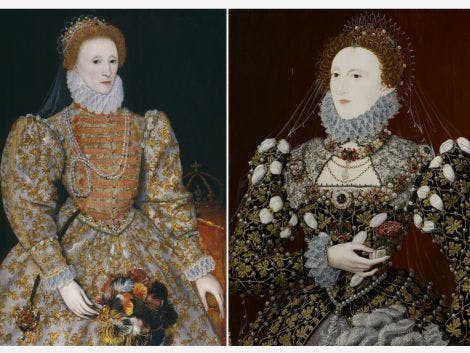
Image: Two Portraits of Elizabeth I, © National Portrait Gallery, London
The empire builder
Always ambitious, Raleigh was also motivated by his hatred of Spain and support for Protestantism.
Once he gained influence at court, he promoted the idea of creating English colonies in North America to challenge Spanish colonial policy.
The Queen wanted to keep her favourite Walter near to her, so he was forbidden to travel overseas.
However, in 1584, 1585 and 1587 Raleigh organised voyages to North America that led to his sponsorship of an English colony on Roanoke Island (now north Carolina), which he named ‘Virginna’ after his adored Virgin Queen, Elizabeth I.
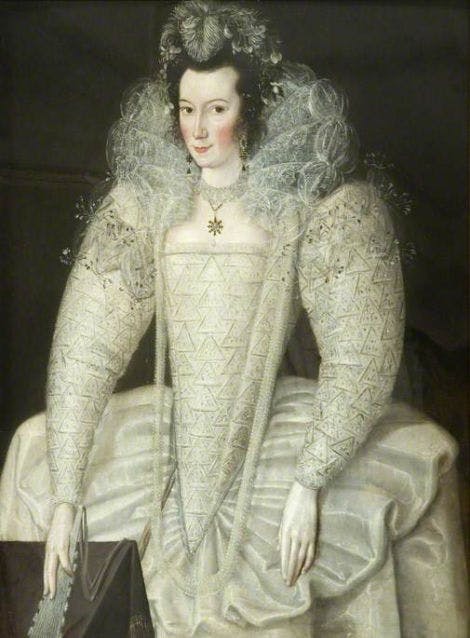
Image: Portrait of a Lady (said to be Elizabeth Throckmorton, d.c.1647, Queen Elizabeth's Maid of Honour and Wife of Sir Walter Raleigh) by Robert Peake (c.1551–1619). © Maldon Moot Hall. Photo credit: Maldon Town Council, CC BY-NC-ND.
Secret marriage to Bess Throckmorton
Although generous, Elizabeth I demanded absolute loyalty. She was furious to learn in 1592 that Sir Walter had secretly married one of her ladies-in-waiting, Elizabeth (‘Bess’) Throckmorton, and even worse, they had a new-born son, Damerei Raleigh.
Walter and Bess were sent to the Tower with their baby. Sadly the baby died after an outbreak of plague, and the Queen, sorry for the grieving mother, soon released her.
Walter was himself released after a few months, but banished from court for five years. He finished the last of his ‘Cynthia’ poems, describing his despair at losing royal favour.
In search of El Dorado
Sadder but no wiser, Raleigh continued his colonial ventures in an attempt to win back the Queen’s affection. He set off to Guinea in South America in search of the mythical golden land of El Dorado.
He also wrote ‘The Discoverie of the Large, Rich and Beautiful Empyre of Guiana’ to promote colonialism, but if Elizabeth was impressed, she didn’t show it.
Did you know?
Raleigh returned to court in 1597, but never again secured the power or influence he had once enjoyed.
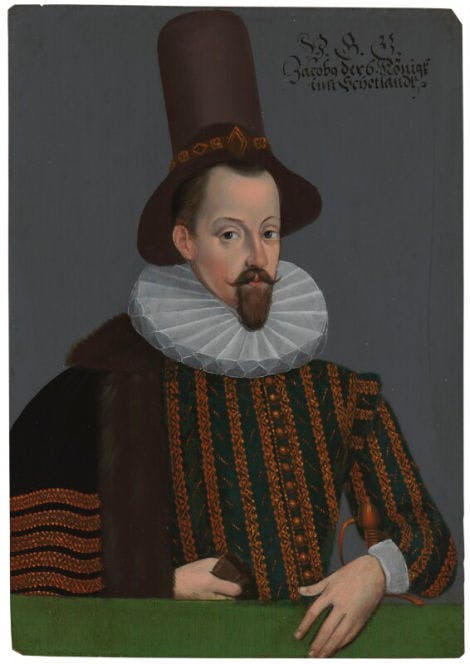
Image: King James I of England and VI of Scotland, © National Portrait Gallery, London.
Raleigh and King James I
In 1603, James VI of Scotland succeeded Elizabeth I as James I of England.
While Raleigh had regained some of his status at court, the King was not as susceptible to his charm as Elizabeth had once been.
Although a Protestant, James was keen to improve relations with Spain. Raleigh’s hatred of Catholics, and opposition to Spanish expansionism in South America were at odds with official policy.
Always a bit of a show-off, Walter’s pride, extravagance and bold talk didn’t help. His enemies at court lost no time poisoning the King’s mind against him.
Back in the Tower
James I was not much loved, either. Although his foreign policies aimed for peace, at home he continued the religious persecutions of the previous reign. Soon conspiracies were being concocted, including the so-called ‘Main Plot’ to replace the King with Lady Arabella Stuart, once considered as a successor to Elizabeth I.
The plotters sought Raleigh’s help, but when the treason was uncovered, his guilt remained unproved. However, he was sentenced to death along with the other conspirators; but escaped this fate when, at the last minute, the King reduced his sentence to life imprisonment in the Tower of London.
Raleigh the romantic
While he was still expecting to die in 1603, Walter wrote a heartbreaking, and revealing, farewell letter to his beloved wife Bess.
After dealing with practicalities of his estate, his debts and his burial, he advised Bess not to grieve overlong, and to marry again, ending:
‘As for me, I am no more yours, nor you mine. Death hath cut us asunder, and God hath divided me from the world and you from me. Remember your poor child for his father’s sake, that comforted you, and loved you in his happiest times.’
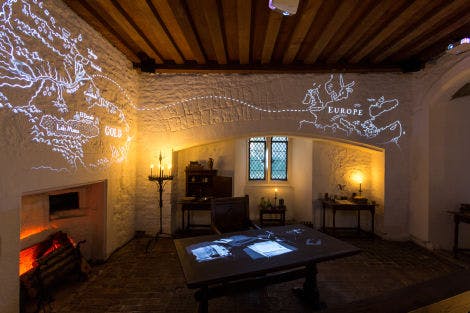
Image: Sir Walter Raleigh's Study downstairs in the Bloody Tower at the Tower of London. © Historic Royal Palaces
The Bloody Tower
When James I showed mercy and reduced his sentence in 1603, Raleigh was sent to the Tower for what he expected would be life imprisonment. He served the next 13 years here.
As befitted a man of his wealth and status, he was given two rooms on the upper floor of the Bloody Tower (then known as the Garden Tower as it overlooked the Tower Lieutenant’s garden), which were well furnished, and relatively spacious.

Image: Portrait of Sir Walter Ralegh (Raleigh) with his son Walter, 1602. @ National Portrait Gallery
Raleigh's family join him in the Tower
His devoted wife Bess, son Walter and three servants were allowed to join him at the Tower of London.
Their second son Carew was conceived in the fortress and born in 1605 in a house on Tower Hill that Bess had rented. The birth was registered in the parish of the Chapel Royal of St Peter ad Vincula.
Walter the apothecary
While imprisoned, Raleigh also grew exotic plants from seeds he had gathered on his travels and brewed his own herbal medicines.
This included his Balsam of Guiana, a potent medicinal cordial of strawberry water, and his ‘Great Cordial’ a mixture of 40 ingredients, including herbs, spices and powders of pearl, deer’s horn and ambergris (a secretion from a sperm whale’s intestines).
During his imprisonment, he received many visitors, including the King’s son, Henry, Prince of Wales, who said: ‘only my father would cage such a bird’.
Watch Sir Walter Raleigh’s medicinal garden at the Tower
During his imprisonment at the Tower, Raleigh brewed his own herbal remedies using plants from his medicinal garden. In this mini-documentary, curator Jane Spooner provides further insight into Raleigh's garden at the fortress.
This content is hosted on YouTube
This content may be using cookies and other technologies for which we need your consent before loading. To view the content, you need to enable cookies for "Targeting Cookies & Other Technologies".
Manage CookiesIn this mini-documentary curator Jane Spooner explores Sir Walter Raleigh's medicinal garden at the Tower of London.
Video Transcript of Sir Walter Raleigh’s medicinal garden at the Tower
Follow along with an interactive transcript of Sir Walter Raleigh’s medicinal garden at the Tower on YouTube. A link to open the transcript can be found in the description.
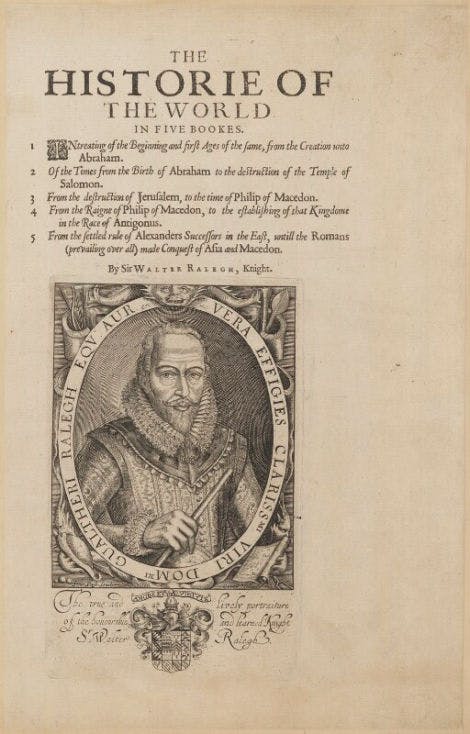
Image: Sir Walter Raleigh's 'The Historie of the World' project by Simon de Passe (published 1617 by Compton Holland) © National Portrait Gallery, London
‘The Historie of the World’
Raleigh also used his imprisonment to write poetry and study chemistry and history. He had access to 500 books in the Tower of London’s library and in 1614 started working on 'The Historie of the World'.
It was originally intended to support Prince Henry’s education, but when the young prince died in 1612, the project was abandoned.
The first five completed volumes were published in 1614, and reveal Raleigh’s understandable cynicism about monarchy. James I and the Archbishop of Canterbury, George Abbot, demanded copies to be seized and publication banned.
Despite their efforts, the book became very popular and was reprinted many times during the 17th-century.
The final expedition
Despite his relative comfort, Sir Walter’s morale and health were poor, and very early in his imprisonment he attempted suicide with a table-knife. The Lieutenant of the Tower, Sir John Peyton commented: ‘I never saw so strange a dejected mind as in Sir Walter Raleigh. I am exceedingly cumbered with him; five or six times a day he sendeth for me in such passions as I see his fortitude is impotent to support his grief.’
In 1616 Sir Walter was released from the Tower by James I (but not pardoned). The King ordered him to undertake an expedition to Guiana to search for gold.
Did you know?
Despite promises to behave diplomatically, Walter’s trip was a fiasco, with Spanish property destroyed and not a single piece of gold to show.
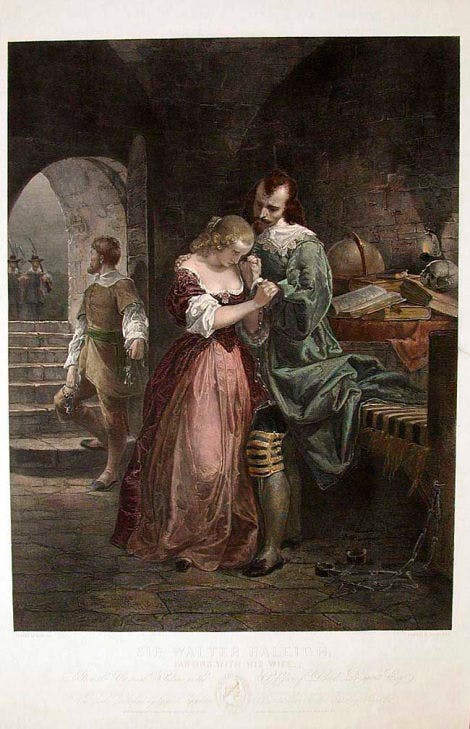
Image: Sir Walter Raleigh Parting with his Wife by Charles Kennedy Burt, after Emanuel Gottlieb Leutze, 1846. © Indianapolis Museum of Art – Gift of Jerry M. Wright
Walter Raleigh's Execution
Upon his return in June 1618, Raleigh was accused of deliberately inciting war between Spain and England.
A furious James I invoked the original sentence of 1603 and by August the explorer was back to the Tower of London, this time in the Beauchamp Tower where, 65 years previously, Lady Jane Grey had been held before her execution.
His imprisonment was short; on 29 October 1618, he was beheaded outside the Palace of Westminster.
Sir Walter Raleigh faced his fate with brave resolution, and supposedly told his executioner, when waiting for the axe to fall: 'Strike, man, strike!'
Eternal love
Raleigh’s head was embalmed and given to his grieving widow Bess, who kept it with her in a red velvet bag for eternal love until she died 29 years later. The bag survives, owned by descendants of their son Carew.
Although Walter’s body was to be buried in his local church at Beddington in Surrey, it was finally laid to rest in St Margaret’s Church, Westminster after Bess died.
Did you know?
Raleigh's tomb is near the High Altar, and a stained glass window, installed above the west door in 1882 shows him sailing for the Americas, his imprisonment and burial.
Who was the real Sir Walter Raleigh?
Now, 400 years after his death, a visit to Raleigh’s study at the Tower of London evokes a complex and brilliant man, the scholar and writer whose adventurous spirit was all but crushed by imprisonment.
Today, the brilliant if flawed explorer, author and apothecary Sir Walter Raleigh is probably best remembered as the man who introduced the potato (which was first grown on his estates in Ireland) and less helpfully, tobacco.
Although sometimes arrogant and reckless, a more tender Raleigh emerges in the words of his 1603 letter to his wife, written while under a sentence of death:
‘My true wife farewell. Bless my poor boy; pray for me. My true God hold you both in His arms.
'Written with the dying hand of, sometimes thy husband, but now (alas!) overthrown, yours that was, but now not my own, W. RALEGH.'
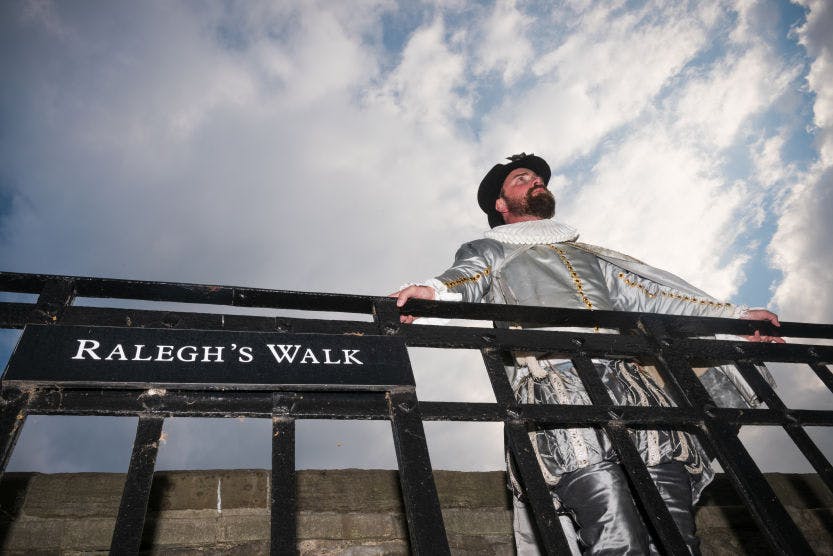
Walter Raleigh: prisoner, scientist and Tower of London gardener
Discover more about Walter Raleigh's imprisonment at the Tower of London with our interactive story, created in partnership with Google Arts & Culture.
Browse more history and stories
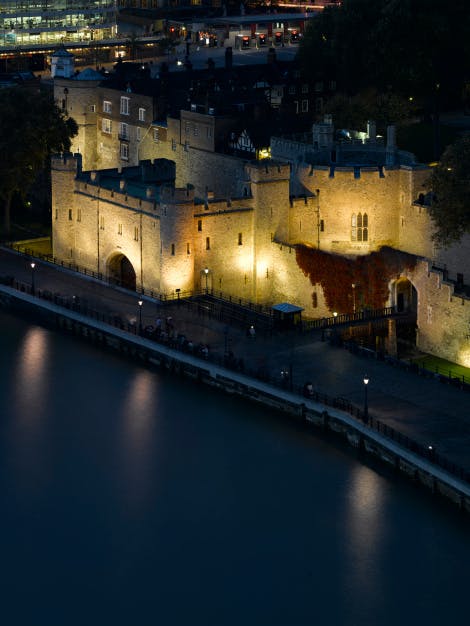
The story of the Tower of London
Iconic fortress, royal palace and infamous prison.

Elizabeth of York
The original Tudor Queen, and wife of Henry VII

Guy Fawkes and the Gunpowder Plot
Who was the real Guy Fawkes, the man behind the mask?
Explore what's on

- Things to see
Torture at the Tower exhibition
Discover stories of the unfortunate prisoners who were tortured within the walls of the Tower of London.
- Open
- Tower of London
- Included in palace admission (Members go free)

- Things to see
Medieval Palace
Newly refurbished in May 2025, discover the colour, splendour, and people of the medieval Tower of London.
-
Open
- Tower of London
- Included in palace admission (Members go free)

- Things to see
Imprisonment at the Tower exhibition
Learn why people ended up as prisoners in the Tower of London, in the very rooms where some of them were held.
- Open
- Tower of London
- Included in palace admission (Members go free)
Shop online

Shop Hanging Decorations
Browse through our beautiful range of hanging decorations, ornaments and baubles including unique and hand-made pieces.
From £5.50

Tower of London Navy Raven Sweatshirt
Inspired by the infamous ravens of the Tower of London, this sweatshirt will keep you warm on those chilly days.
£38.00

Shop Six Wives of Henry VIII
'Divorced, Beheaded, Died: Divorced, Beheaded, Survived' - this best selling range is as colourful as it is informative.
From £15

